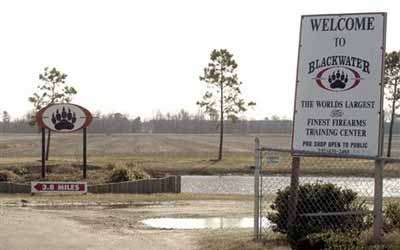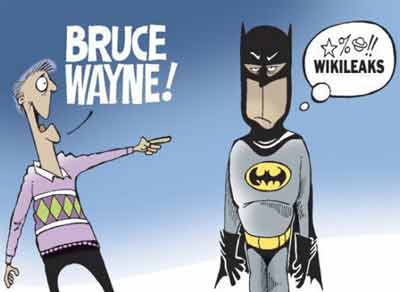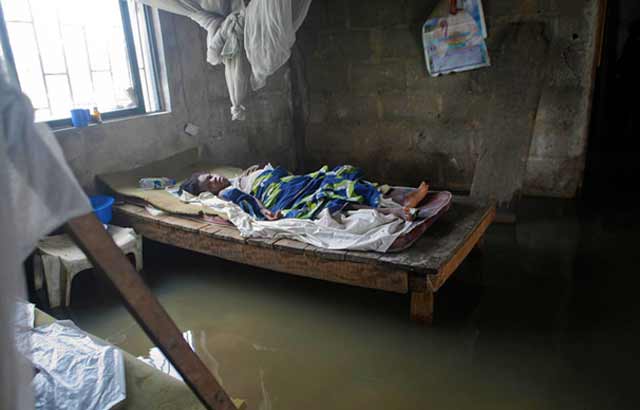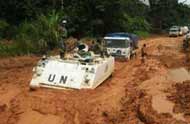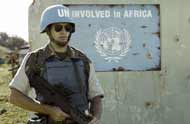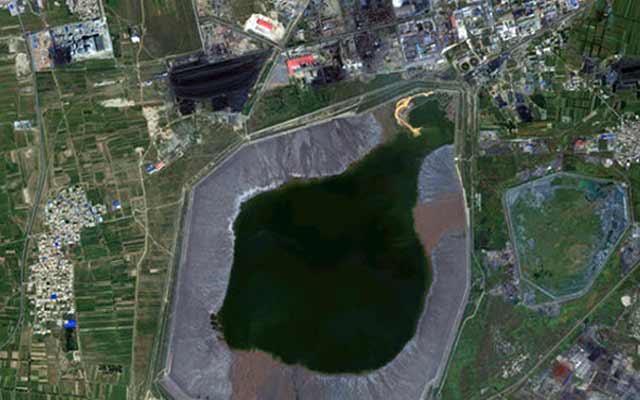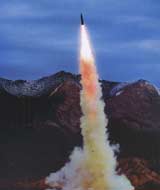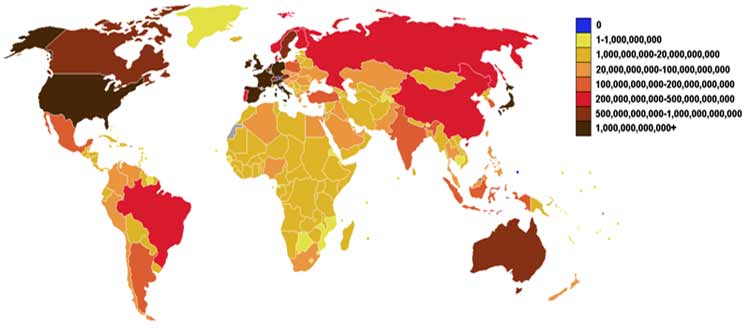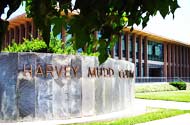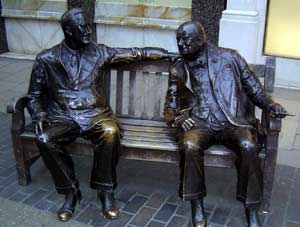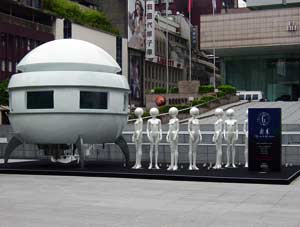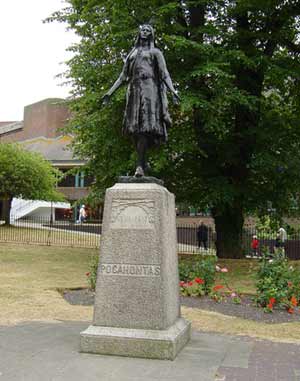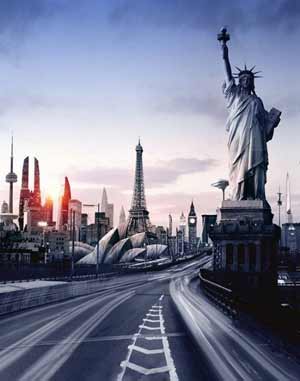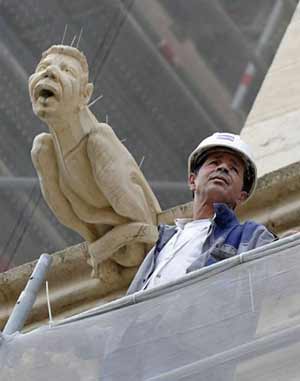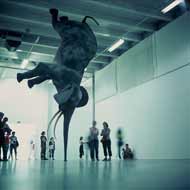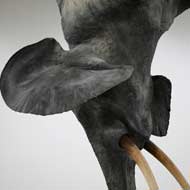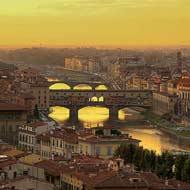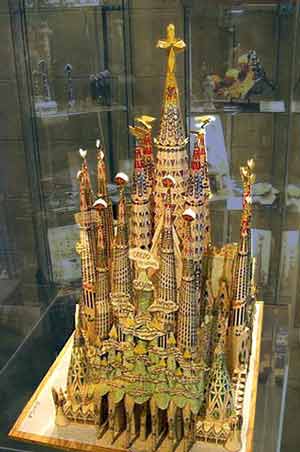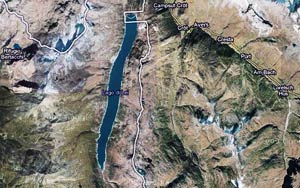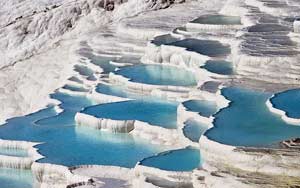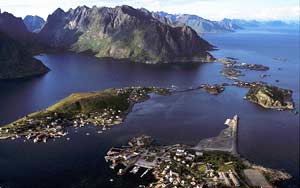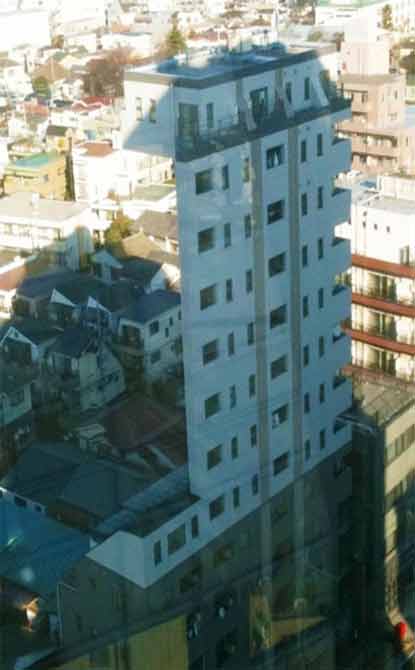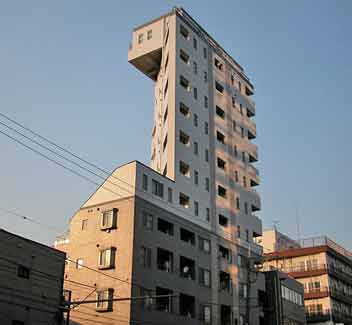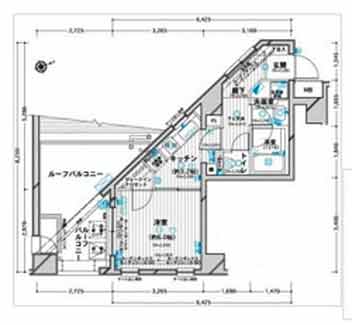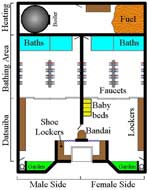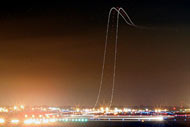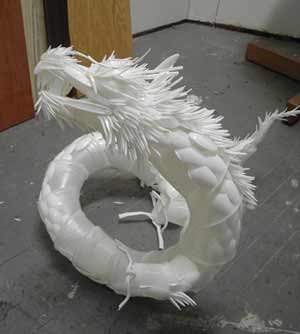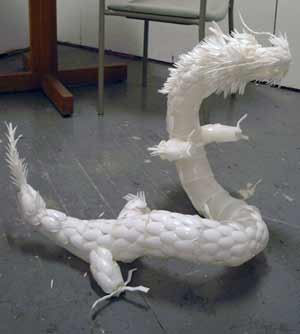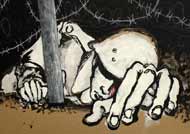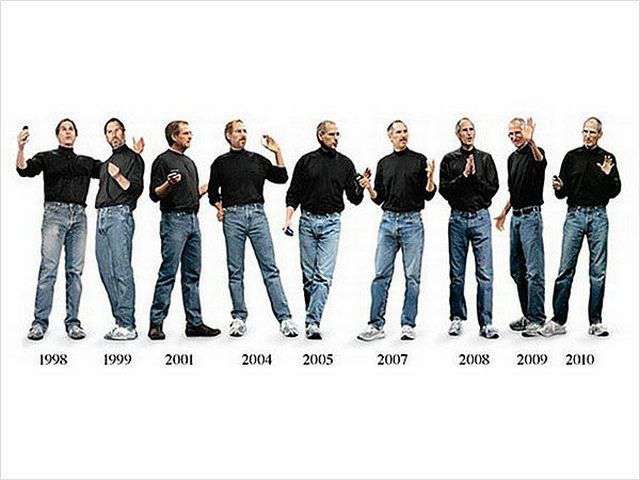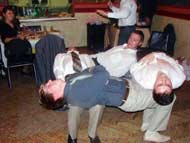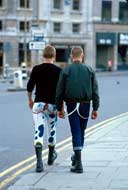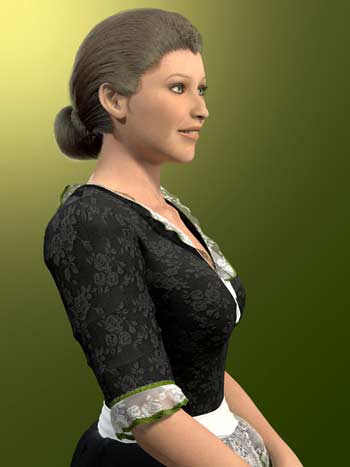“So what are these Blackwater operatives? Peacekeepers? Law enforcers? Dogs of war? Armed goons? Are they the new Stasi? Kala Pani, literally “Black water” in Urdu/Hindi languages, is a term for the deep sea and hence exile. It was also the name of a notorious cellular jail situated in the Andaman and Nicobar Islands (India). This prison housed notable Indian activists during India’s struggle for independence. In 1868, 238 prisoners escaped. Within a month, all were caught. Of these, the Brits hanged 87. On the US mainland, the Blackwater River of Florida is a 58-mile long river arising in southern Alabama and flowing through the Florida Panhandle to the Gulf of Mexico (Blackwater Bay, an arm of Pensacola Bay) after passing through Blackwater River State Park. There is yet another black water river in North Carolina that goes by the name of the White Oak River. It is located in the outer coastal plain province. And also in North Carolina is a private military company, Blackwater USA…” - Anwaar Hussain
Glory is fleeting, but obscurity is forever.
—Ubi Dubium Ibi Libertas
Jan. 15, 2011
The page title is a Latin proverb meaning, “Where there is doubt, there is freedom.”
| On 24 December 2006, Andrew J Moonen, a Blackwater armorer, was accused of killing a guard assigned to an Iraqi vice president. Later, 5 former Blackwater guards were indicted on manslaughter and related weapons charges in a September 2007 shooting incident in Nisour Square in Baghdad in which 17 Iraqi civilians were killed. In the immediate aftermath of the Christmas Eve shooting, Mr Moonen was interviewed, not by the FBI, but by an official with the Regional Security Office of the US Embassy in Baghdad, the State Department unit that supervised Blackwater security guards in Iraq. Mr Moonen’s lawyer said that his client gave the embassy officials a statement only after he was issued a so-called Garrity warning — a threat that he might lose his job if he didn’t talk, but that he would be granted immunity from prosecution for anything he said. The legal warning and protection given Mr Moonen were similar to warnings that embassy officials later gave to the Blackwater guards involved in the Nisour Square case. In each incident, these agreements presented an obstacle to prosecution in the US. In effect, the Blackwater personnel were given a form of immunity from prosecution by the people they were working for and helping to protect. “Once you immunise statements, it’s really hard to prosecute,” said Andrew Leipold, a law professor at the University of Illinois. “In the field, the people providing immunity may value finding out what happened more than they do any possibility of prosecution. But that just makes future prosecution really very hard.” Moonen’s lawyer says he believes his client was only indicted to placate the Iraqi government. (Who else would care about murdered Iraqi civilians?) |
||
| And Assange? Hopefully he will have a long reprieve from premature burial. Ecuador offered him sanctuary until the US Embassy in Quito gave the president a swift command and the invitation was rescinded. Switzerland? Istanbul? Hmmm. He should, at the least, view with caution women eagerly inviting his embraces and certainly stay away from overpasses, bridges, and open windows. In 1953 the CIA distributed to its agents and operatives a killer’s training manual (made public in 1997) full of hands-on advice: “The most efficient accident, in simple assassination, is a fall of 75 feet or more onto a hard surface. Elevator shafts, stairwells, unscreened windows and bridges will serve… The act may be executed by sudden, vigorous [excised] of the ankles, tipping the subject over the edge. If the assassin immediately sets up an outcry, playing the 'horrified witness’, no alibi or surreptitious withdrawal is necessary.” (Good to know.) |
||
Says Assange: “While an organisation structured by direct and open lines of communication will be much more vulnerable to outside penetration, the more opaque it becomes to itself (as a defense against the outside gaze), the less able it will be to 'think’ as a system, to communicate with itself. The more conspiratorial it becomes, in a certain sense, the less effective it will be as a conspiracy. The more closed the network is to outside intrusion, the less able it is to engage with that which is outside itself.” He adds that Wikileaks does not leak something like the “Collateral Murder” video as a way of putting an end to that particular military tactic; that would be to target a specific leg of the hydra even as it grows two more. Instead, the idea is that increasing the porousness of the conspiracy’s information system will impede its functioning, that the conspiracy will turn against itself in self-defense, clamping down on its own information flows in ways that will then impede its own cognitive function. You destroy the conspiracy, in other words, by making it so paranoid of itself that it can no longer conspire. What is emerging from all the sound and Wikileaks fury in Washington is that the entire scandal is serving to advance a long-standing Obama and Bush agenda of policing the until-now free Internet. Already the US Government has shut the Wikileaks server in the US, though no identifiable US law has been broken. The Cybersecurity Act of 2009 (S.773) would give the President unlimited power to disconnect private-sector computers from the internet. The bill “would allow the president to 'declare a cyber-security emergency’ relating to 'non-governmental’ computer networks and do what’s necessary to respond to the threat.” We can now expect that this controversial piece of legislation will get top priority when a new Republican House and the Senate convene in January. Thanks to Tywkiwdbi.
| The issue here is causation, not justification. The great contradiction of American foreign policy is that the very actions endlessly rationalised as necessary for combating terrorism — invading, occupying and bombing other countries, limitless interference in the Muslim world, unconditional support for Israeli aggression, vast civil liberties abridgments such as torture, renditions, due-process-free imprisonments — are the very actions that fuel the anti-American hatred which, as the US Government itself has long recognised, is what causes, fuels and exacerbates the terrorism we’re ostensibly attempting to address. It’s really quite simple: if we continue to bring violence to that part of the world, then that part of the world — and those who sympathise with it — will continue to want to bring violence to the US.
|
||
| “We in The National Realist Association do not want to outlaw the belief in human rights. That would be absurd. But it is just as absurd, and surely more dangerous, for the rightists to have a specially privileged position. They are allowed to teach in schools, and even protected against discrimination laws and allowed to sack anyone who doesn’t believe in Human Rights. And yet there is no evidence that human rights exist at all. They should be taught in schools as part of a balanced curriculum, one in which such practices as slavery and torture are discussed on their merits — for they have never been more popular nor as widely practised as they are in the world today — and they, at least, exist, which no one has ever proved that human rights could do. There is no instance of supposed human rights which cannot be better explained by a modern biological analysis of power arrangements in which 'Genteel’ ideas of vaguely benevolent mutual co-operation are replaced by an expectation of stark, ruthless, opportunistic mutual exploitation.” We are after all, animals, another fact that makes the idea of specially “human” rights ridiculous. |
||
More on the issue of human rights: A sick youth lies on a bed in a flooded hospital in Ajegunle, Nigeria. The UN Office for the Coordination of Humanitarian Affairs says an epidemic of cholera — a water-borne illness — has killed nearly 1,200 Nigerians.
| Metaphor — I could find no information about this other than what can be gleaned from the picture itself. |
||
| This photo is undoubtedly meant as a joke. Yet it seems clear to me from just these 3 photos that the UN’s job may be a bit more difficult than I had heretofore realised. |
||
The export quotas China continues to impose on rare earths are restricting global supplies and causing world market prices to soar far beyond what Chinese companies pay. From the Chinese perspective, though, the issue looks very different. China currently controls most of the globe’s rare earths supply not just because of geologic good fortune, but because the country has been willing to do dirty, toxic and often radioactive work that the rest of the world has long shunned. Despite producing 95% of the world’s rare earths, China has only 37% of the world’s proven reserves. Sizable deposits are known to exist in the US, Canada, Australia, India and Brazil. Across China, rare earth mines have scarred valleys by stripping topsoil and pumping acid into streambeds. At Batou, the bottom of the reservoir was not properly lined when it was built decades ago and a slowly spreading stain of faint but detectable radioactivity in the groundwater is moving at a rate of 300 yards a year toward the Yellow River, 7 miles to the south.
| A new Chinese anti-ship missile will significantly alter the balance of military power in the Pacific according to the top US commander in the Pacific, Admiral Robert Willard. Defence analysts have called the Dongfeng 21 D missile a “game changer” since it could force US aircraft carriers to stay away from waters where China does not want to see them. These include the Taiwan Strait where a potential conflict could develop over the self-ruled island which China claims. The land-based missile is designed to target and track aircraft carrier groups with the help of satellites, unmanned aerial vehicles and over-the-horizon radar. Aircraft carriers and their accompanying ships are unable to defend themselves against such a threat. Aware of the missile’s development, the Pentagon is considering ways to counter this new threat, including a new concept for more closely integrated naval and air force operations. (And if new equipment is needed — Robert Gates, the US defence secretary, announced a 5-year military budget that would include funding for a new generation of long-range bombers, as well as for new electronic jammers and radar — the US will most likely borrow the money from China to pay for it?) |
||
| Liang Guanglie is the current Minister for National Defense in the People’s Republic of China and a General in the People’s Liberation Army of China. "In the coming 5 years, our military will push forward preparations for military conflict in every strategic direction,” says Mr Liang. “We may be living in peaceful times, but we can never forget war, never send the horses south or put the bayonets and guns away.” China repeatedly says it is planning a “peaceful rise” but the recent pace and scale of its military modernisation has alarmed many of its neighbours in the Asia-Pacific. I would suggest that China has raw matereials — including quantities of rare earths — that it may consider need protecting. |
||
A useful measure of a country’s debt position is to compare gross external debt to GDP. By comparing a country’s debt to what it produces, the resulting ratio can be used to help determine the likelihood that the country will be able to repay its debt. A massive external debt could trigger an exchange rate devaluation, especially if a country relies heavily on imports, creating a situation where money is more difficult to tax in the future, debts more difficult to repay with less-valuable currency and issues of fiscal sustainability arise. However, there’s really no single “danger” level for having too much external debt as a percentage of GDP — this depends much more on the country’s economic context. The US has the 20th largest debt-to-GDP ratio (94.3%), with a gross external debt of $13.454 trillion and annual GDP $14.26 trillion. In fact, out of the largest 75 economies, this number is only just above the worldwide average (90.8%). Western European and North American countries dominate the upper end of the spectrum, with Switzerland (422%) and the United Kingdom (408%) at the #2 and #3 spots respectively, and Ireland representing the most drastic debt-to-GDP ratio. According to the most recent World Bank data, Ireland’s number stands at a staggering 1,267%. (Even if the banking sector is removed from the total external debt number, Ireland still has a 748% debt-to-GDP ratio, keeping the country at the top spot.) And small countries like Monaco or Luxembourg have disproportionate debt-to-GDP ratios of 1,850% and 4,910% respectively. In comparison, notable countries which have extremely low debt-to-GDP ratios are Brazil (13%), Singapore (10.7%), China (4.7%) and India (4.6%). The lowest ratio is boasted by Algeria (1.2%). Too low a ratio may not necessarily be a good thing as it could reflect a combination of lack of foreign investment, low confidence in the nation’s finances, and/or absence of debt-funded growth and investment policies by the national government. Yet the policy of taking on excessive debt cannot be perpetually sustained, no matter what the size of a debtor nation’s domestic economy.
| From a look at the world’s 75 largest economies, these are the top 20 debtor nations (updated 30 Sept 2010): |
||
| “Colleges That Bring The Highest Paycheck 2011: In the number 1 spot we have… Harvey Mudd College (which, I’m embarassed to admit, I had not heard of). Mid-career median salary: $126,000. Starting median salary: $68,900. Location: Claremont, California. 2010 — 2011 tuition: $40,390. College rank: 18 (Liberal Arts). Acceptance rate: 34%. Total undergrad enrollment: 757. Harvey Mudd College places an unusually strong emphasis on general science education, requiring a full 1/3 of math, science, and engineering courses, known as the “common core,” outside of one’s major. Students are also required to take another 1/3 of their courses in the humanities, in keeping with the school’s tradition of “science with a conscience.” The final 1/3 of courses comprises those in the student’s major. The integration of research and education is an important component of the educational experience at Harvey Mudd; upon graduation, every student has experienced some kind of research, usually in the form of a senior thesis or a Clinic Programme. The college offers 4-year degrees in chemistry, mathematics, physics, computer science, biology, and engineering, as well as interdisciplinary degrees in mathematical biology, and a joint major in either computer science and mathematics or biology and chemistry. Students may also elect to complete an Independent Program of Study (IPS) made up of courses of their own choosing. Usually between 2 and 5 students graduate with an IPS degree each year. Finally, one may choose an off-campus major offered by any of the other Claremont Colleges, provided one also completes a minor in one of the technical fields that Harvey Mudd offers as a major. A third of the student body are National Merit Scholars, and at one point, about 40% of graduates were going on to earn a Phd — the highest rate of any college or university in the nation. |
||
Google has made $11.1 billion overseas since 2007. It (legally) paid just 2.4% of that in taxes. Google does business in many advanced capitalist countries with high tax rates — for example, the corporate tax rate in the UK is 28%. Most leading high-tech companies use remarkably similar techniques to achieve similar results. How? Google’s office in Ireland is the centre of the company’s international operations. In 2009, it was credited with 88% of its $12.5 billion in sales outside the US. According to Business Week, most of the profits went to Bermuda (where there is no corporate income tax) via a convoluted route known to tax lawyers as the “Double Irish” and the “Dutch Sandwich.” When a company in Europe, the Middle East, or Africa purchases a search ad through Google, it sends the money to Google Ireland. The Irish government taxes corporate profits at 12.5%, but Google mostly escapes that tax because its earnings don’t stay in the Dublin office (which reported a pretax profit of less than 1% of revenues in 2008). Irish law makes it difficult for Google to send the money directly to Bermuda without incurring a large tax hit, so the payment makes a brief detour through the Netherlands, since Ireland doesn’t tax certain payments to companies in other European Union states. Once the money is in the Netherlands, Google can take advantage of generous Dutch tax laws. Its subsidiary there, Google Netherlands Holdings, is just a shell (no employees) and passes 99.8% of what it collects to Bermuda. (The subsidiary managed in Bermuda is technically an Irish company, hence the “Double Irish” nickname.) This set-up helps Google lower its tax bill in the US because Google Ireland licenses its search and advertising technology from Google headquarters in Mountain View, California. While this technology is worth a lot, Google headquarters keeps the fee to Google Ireland low so that Google headquarters can minimise US earnings and US tax obligations. Sweet. For some.
| “I don’t think it’s healthy to have an imaginary friend.” – Catholic priest on FOX News. According to Fox, 75% of Americans pray on a weekly basis (but they don’t say how many of those prayers are directed to imaginary gods). Via Cynical-C. |
||
| Staying even can be harder than getting even… | ||
The following are items related to recent posts. I received or discovered these too late to include them in my original post. Better late than never. Maybe.
- New York — New York uses the New York City influence of its name in several ways. Its architecture is meant to evoke the New York City skyline; the hotel includes several towers configured to resemble New York’s, such as the Empire State Building and the Chrysler Building. In front of the property is a lake representing New York Harbor, with a 150-foot-tall (46-metre) replica of the Statue of Liberty and replicas of the Soldiers and Sailors Monument, the Whitney Museum of American Art, the Main Immigration Building on Ellis Island, and the Grand Central Terminal. Within the resort, particular gambling areas, lounges, restaurants, and meeting rooms are named after New York City neighbourhoods or landmarks. The main casino area, for example, is named after Central Park, while the shops are modelled after Greenwich Village. The property opened January 1997, a joint venture of MGM Grand and Primadonna Resorts. The twin towers of the World Trade Center were not included in the skyscrapers depicted as the facade is meant to represent New York City as it was in the 1940s.
- Roosevelt and Churchill — Bond Street — London I wonder — is the bench bronze? Or wood? Does anyone reading this know? The sculpture was commissioned by the Bond Street Association — local shops and businesses — and presented to the City of Westminster in 1995, to celebrate 50 years of peace. It’s by Lawrence Holofcener. There is just enough room to squeeze yourself in between the President and the PM to take a rather unusual photo. It is implied that the bench is bronze. (“The bench looks absolutely real.”)
- Taipei Space Girls — Jhongshan District, Taipei City, Taiwan. I could find no information of this whatsoever. I don’t know the artist nor if it’s a temporary or a permanent installation.
- Pocahontas — Later known as Rebecca Rolfe, Pocahontas was a Virginia Indian chief’s daughter notable for having assisted colonial settlers at Jamestown. She converted to Christianity and married the English settler John Rolfe. After they travelled to London, she became famous in the last year of her life. She was a daughter of Wahunsunacawh, better known as Chief or Emperor Powhatan (to indicate his primacy), who headed a network of tributary tribal nations in the Tidewater region of Virginia. These tribes made up what is known as the Powhatan Chiefdom and spoke a language of the Algonquian family. In March 1617, Rolfe and Pocahontas boarded a ship to return to Virginia, however, the ship had only gone as far as Gravesend on the River Thames when Pocahontas became seriously ill. She was taken ashore and died. It is unknown what caused her death, but theories range from smallpox, pneumonia, or tuberculosis, to her having been poisoned. According to Rolfe, she died saying, “All must die, but tis enough that her child liveth.” Her funeral took place in Gravesend. The site of her actual grave is unknown, but her memory is honoured in Gravesend with a life-size bronze statue at St George’s Church.
- Getting the Most out of Your Vacation — Benedict Campbell photography. More.
- Ahmed the Gargoyle — Gargoyles grinning down from the majestic St Jean Cathedral in Lyon, France, may in recent centuries have lost their power to intimidate sinners, but a new arrival has perturbed some hardliners. In line with medieval tradition, a stonemason who worked on the edifice’s latest renovation has himself been immortalised in stone — in this case, as a new gargoyle named Ahmed, perched over the inscription “Allahu Akbar”. The statue is named after Ahmed Benzizine, a Muslim who has been employed by the firm carrying out the work for 30 years. Church officials have no problem with the caricature, but a local conservative group is angry. Stonemason Emmanuel Fourchet decided to carve “Ahmed” as a gargoyle — a demonic medieval statue that hangs from a cathedral as both a form of rain gutter and an admonishment to the faithful — in tribute to his friend. The “God is Great” inscription underneath, in both French and Arabic, is a tribute to his colleague’s faith, and was not meant as a slight to Christian worshippers who still use St Jean 8 centures after it was built. (Thanks, Pete.)
| Würsa (18,000 Kilometres from Earth) is a sculpture by Daniel Firman for the exhibition Superdome at the Palais de Tokyo, Du 29 mai au 24 août 2008. That’s what an elephant can do in nearly weightless orbit. It’s worth checking out the photos of how the taxidermist prepared this sculpture. Taxidermist? For a sculpture? There seems to be a disconnect here. The elephant went from the Superdome in Paris to an exhibit at the Fontainebleau, where I first learned of it. (And thanks again, Pete.) |
| Dante was standing near the Ponte Vecchio, a bridge that crosses the Arno River in Florence. It was just before 1300. Dante saw Beatrice standing on the bridge. He was a young man, she even younger, and that vision contained the whole of eternity for him. Dante did not speak to her. He saw her very little. And then Beatrice died, carried off by plague. Dante was stricken with the loss of his vision. She was the intermediary between his soul and heaven itself. 650 years later, during World War II, the Americans were chasing the German army up the Italian “boot.” The Germans were blowing up everything of aid to the progression of the American army, including the bridges across the Arno River. But no one wanted to blow up the Ponte Vecchio, because Beatrice had stood on it and Dante had written about her. So the German army made radio contact with the Americans and, in plain language, said they would leave the Ponte Vecchio intact if the Americans would promise not to use it. The promise was held. The bridge was not blown up, and not one American soldier or piece of equipment went across it. We’re such hard bitten people that we need hard bitten proof of things, and this is a hard bitten fact. The bridge was spared, in a modern, ruthless war, because Beatrice had stood upon it. — Robert Johnson The Figure of Beatrice in Dante’s Divine Comedy. |
Geography
- The Basilica and Expiatory Church of the Holy Family, commonly known as the Sagrada Família, is a large Roman Catholic church in Barcelona, Catalonia, Spain, designed by Catalan architect Antoni Gaudí (1852 – 1926). Construction has continued intermittently since commencing in 1882, reaching 15 — 25% complete by the time of Gaudi’s death. Work continued until interrupted by the Spanish Civil War in 1936. Parts of the unfinished basilica and Gaudí's models and workshop were destroyed during the war by Catalan anarchists. The present design is based on reconstructed versions of the lost plans as well as on modern adaptations. By 2010, construction passed the mid-point with some of the project’s greatest challenges remaining. Completion is anticipated in 2026 — the centennial of Gaudí's death. Computer-aided design technology has been used to accelerate construction, which had previously been expected to last for several hundred years based on building techniques available in the early 20th century. Current technology allows stone to be shaped off-site by a CNC milling machine, whereas in the 20th century, the stone was carved by hand. George Orwell called the Sagrada Familia “one of the most hideous buildings in the world” and James A Michener called it “one of the strangest-looking serious buildings in the world.” More.
- This is a ship in the Corinthos (Korinthos) Canal. The canal carries ship traffic between the western Mediterranean and the Aegean Sea. The canal it is about 4 kilometres (2.5 miles) east of Corinth, cutting through the Isthmus. This channel was designed and built between 1881 — 1893 by Béla Gerster and István Türr, with 4 other Hungarian engineers. The Canal is 6.3 kilometres (3.9 miles) long, 24 metres (79 feet) wide, 8 metres (26 feet) deep; 4,000 people and 450 tons of dynamite were neeeded to build it. The canal was cut through heavily faulted sedimentary rock in an active seismic zone. Between 1893 and 1940, it was closed for a total of 4 years for maintenance and to stabilise the walls. In 1923 alone, 41,000 cubic metres of material fell into the canal, which required 2 years to clear out.
- If a country disappears, is it still a country? Does it keep its seat at the United Nations? Who controls its offshore mineral rights? Its shipping lanes? Its fish? And if entire populations are forced to relocate — as could be the case with citizens of the Maldives, Tuvalu, Kiribati and other small island states facing extinction — what citizenship, if any, can those displaced people claim? What will the political status of those displaced people be? Will they assimilate into the culture and economy of their new host country, or will they retain a separate identity? “The core issue is that we have written our laws, regulations, and subsidies on the assumption that the environment is a constant, and it isn’t.” Like many atolls in the Pacific Ocean, Aitutaki in the Cook Islands rises only a few metres above sea level. Several island nations are composed entirely of low-lying islands and atolls, making them especially vulnerable to rising sea levels.
- Consider the Swiss-Italian border, remarkable enough in its entirety. As it zigzags across valleys and mountaintops of the Alps, 3 Italian protrusions northward are matched by 3 territorial thrusts south by the Swiss. Zooming in — as Google Maps now so handily allows — reveals two intriguing anomalies. Fifteen miles northwest of Como, the Italian city adjacent to Switzerland’s southernmost point, is the enclave of Campione d’Italia, a speck of Italian territory surrounded by Switzerland on the shores of Lake Lugano. Next, just west of the Swiss town of Avers, the border (now dividing Italy to the west from Switzerland to the east), suddenly juts out into what appears to be a perfectly rectangular box, exactly 1 kilometre long and 500 metres wide (3,300 by 1,700 feet). Odd as this is in itself, its geophysical context is positively intriguing. The box is situated at the northern end of the Lago di Lei, a meridionally-oriented lake at an altitude of about 2,000 metres (6,500 feet), about 7.7 kilometres (4.8 miles) long and 133 metres (435 feet) deep. It runs parallel to the border just to its east. Lago di Lei is an artificial lake, created by the hydroelectric dam at its north end. It is precisely this dam that is enclosed by the anomalous box. So we have an Italian reservoir controlled by a Swiss dam. Why? And who gets the electricity? There is very little information to be found on the Valle di Lei, even less on the construction of the Lago and almost nothing on the border anomaly itself. “The dam is a masterpiece of Italian engineering, construction and labour. As the valley was inaccessible, two cable lifts were constructed over a distance of 15 kilometres (9.3 miles), one for the workforce (numbering approximately 1,500), the other for their material. Work started in summer of 1957, the reservoir was filled for the first time in the autumn of 1962.” The text fails to explain why, after all this effort, the Italian government would sign over the dam to Switzerland (or how much territory they got in return).
- Travertine is a terrestrial sedimentary rock, formed by water travelling through limestone and emerging as hot springs, then cooling rapidly. The minerals it collects on its journey are captured as rich and creamy colours, frequently complemented by tiny shell patterns. Pamukkale is (literally) Turkey’s “Cotton Castle”; it is the site of the ancient city of Hierapolis, a Greek-speaking spa town, very popular with the wealthy of the ancient world for centuries, but now mostly reclaimed by the deposits. People are allowed to bathe in the travertine pools but are not allowed to wear shoes as these may damage it. The site is home to not one but 17 hot water springs which have varied temperatures from lukewarm to boiling hot. Transported over several hundred metres, the water is then deposited into the travertine terraces. The calcium carbonate is first deposited as a soft gel, which eventually hardens (hence the ban on footwear), and then becomes part of the structure of the travertine.
- Lofoten is an archipelago and a traditional district in the county of Nordland, Norway. Though lying within the Arctic Circle, the archipelago experiences one of the world’s largest elevated temperature anomalies relative to its high latitude. The name means, roughly, “lynx foot” — the shape of the island must have been compared with a foot of a lynx. (The old name of the neighbouring island Flakstadøya was Vargfót, “wolf foot”.) The islands have for more than 1,000 years been the centre of great cod fisheries, especially in winter, when the cod migrates south from the Barents Sea and gathers in Lofoten to spawn. The Lofoten Islands are characterised by their mountains and peaks, sheltered inlets, stretches of seashore and large virgin areas. The sea is rich with life, and the world’s largest deep water coral reef is located west of Røst. Lofoten has a very high density of sea eagles and cormorants, and millions of other sea birds, among them the colourful puffin. Otters are common, and there are moose on the largest islands. Winter temperatures in Lofoten are very mild considering the location north of the Arctic Circle, this is the largest positive-temperature anomaly in the world relative to latitude due to the Gulf Stream and its extensions — the most northerly locations in the world where average temperatures are above freezing all year.
| There are giant basalt columns at the south of Staffa and the entrance to Fingal’s Cave. An Irish giant in legend constructed a causeway starting from hexagonal basalt columns in Ireland across to Scotland. Previously it had been known in Gaelic as “the melodius cave” (Uamh Bhin) from the sounds made by the waves lapping in its 150-foot channel, echoed by the roof like a giant natural cathedral. Staffa (from the Old Norse for stave or pillar) Island, is an island of the Inner Hebrides in Argyll and Bute, Scotland. The Vikings gave it this name as its columnar basalt reminded them of their houses, which were built from vertically placed tree-logs. Staffa lies about 10 kilometres (6.2 miles) west of the Isle of Mull. The area is 33 hectares (0.13 square miles). The island came to prominence in the late 18th century after a visit by Sir Joseph Banks. He and his fellow travellers extolled the natural beauty of the basalt columns in general and of the island’s main sea cavern which Banks re-named Fingal’s Cave. Their visit was followed by that of many other prominent personalities throughout the next two centuries, including Queen Victoria and Felix Mendelssohn. The latter’s Hebrides Overture brought further fame to the island. |
| The Armadillo, Scottish Exhibition and Convention Centre (SECC), completed and opened in 1997, is officially named the Clyde Auditorium. This reminds me rather a lot of the Sydney Opera House. Google aerial map. |
||
Incredibly Odd Building.
From Google’s translation of the rental ad for an apartment in this building — Property Type: Apartment. 6 mins to nearest mainline Keihin. (Note: the Keihin Region consists of the Japanese cities Tokyo, Kawasaki, and Yokohama. The term is mostly used to describe these cities as one industrial region.) Oomori 15 minutes by JR Keihin Tohoku Line. (Note: I gather JR is Japan Railroad.) Location Minamiooi Shinagawa. Reinforced concrete structure, 13 stories, built 2002. Bicycle lock (?), 2-burner stove, security cameras, gas, cook chasing bath (? kitchen sink, perhaps?), dry bath, and instruments available (?!), indoor yard washing machine, courier boxes, apartment rental office available. Pets allowed, flooring (they have to tell you this?), balcony, separate bathroom and toilet, shower, cable TV, auto lock, elevator, air conditioning, bidet, intercom, Internet cable.
| Taking furo (bath) in Japan: Is it embarrassing for you to go to a sento (public bath) or an onsen (hot spring) and be naked in front of other people? The furo (bath) is indispensable to Japanese life. They say “hadaka no tsukiai,” literally meaning “naked relationship,” to express deep friendship. If you take a bath with someone, that means you’re buddies. The image at left is the public bath symbol — they’re everywhere around Japan. Swimsuits are not allowed — while it might be embarrassing the first time, it’s a shortcut to friendship with someone to take furo together. (A shower could do that, too depending on just whom you want to be friends with — and you can do it in your own home — but that’s just a Westerner talking, I guess.) A sento is a public bath using tap water for people living in rooms or houses without a bath. A “super sento” is for people who have baths but want to have fun and relax in a bigger one or who want to use a sauna. An onsen is a public bath using hot water from a natural hot spring (these are located all over, though usually Japanese people prefer onsens in the mountains for the atmosphere). Some onsen have unique water colour or smell. Basic manners: Bring both a washcloth and a bath towel. Undress at the datsuijyo (changing room). Leave your large towel and clothes there, taking only the washcloth; go to the yokujyo (bathroom). Strictly speaking, tattooed persons are NOT allowed in public baths, though if it’s small, it may be okay.) Wash yourself at an araiba (shower), scrubbing with soap (never skip this step!). You can shave or brush your teeth if you like, but DON’T wash undies. Now enter a bath and relax — but don’t put the washcloth in the water! (The Japanese often put theirs on their heads.) If there’s a sauna you’d like to try, wipe your body with the washcloth before entering. After the sauna, shower (to wash away sweat) before getting back in a bath. Before leaving, shower again. Wipe your body with the washcloth before going back to the changing room. There, dry off and dress. In all, it takes about an hour. Bathing at a Japanese home: The rule of taking a thorough shower before entering a bathtub applies in home baths as well because usually the whole family uses the same tub of hot water. After bathing, remove any hairs or dirt you’ve introduced. Traditionally the guest or else the father has the right to take the ichiban-buro (the first bath of the day). |
||
| Years ago, most houses in Japan didn’t have a bathtub or shower. Everyone went to the neighbourhood public bath — it was a ritual every evening (almost everyone bathed in the evening rather than in the morning), not simply to get clean, but for traditional bonding. The neighbours would socialise and become closer through the public bath. Now that most everyone has a bathtub and shower in their houses, the public bath isn’t used as often and they’re becoming less and less common. Many feel that’s regrettable. If you visit Japan, you should try a public bath at least once. You can find them by their chimneys. Also, many have the symbol for hot water somewhere on the building. And they usually have a laundromat in front. If you use a Japanese public bath, you’ll find separate men’s and a women’s sections. The bath tub is for relaxing after you’re clean, not for washing. Also, most public baths in Japan sell milk. It’s a Japanese tradition to drink milk after visiting a public bath. |
||


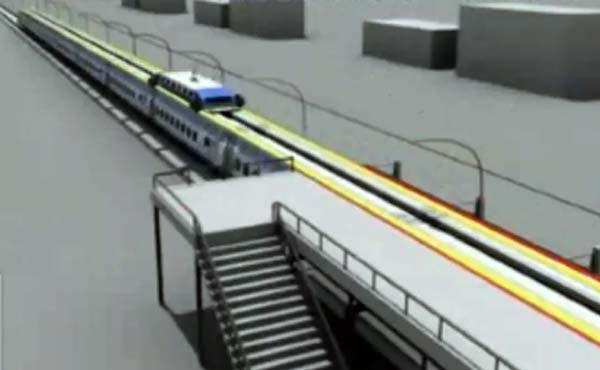

The train that never stops at a station: 1.) Passengers enter a “connector cabin” long before the train arrives. 2.) The train, which does not stop, drives under the connector cabin, slowing enough to engage it via a slot on the train’s roof. 3.) As the train moves away from the station, it takes this cabin with it. 4.) It also drops a different connector cabin off the back of the train in which are those people who had been on the train who wish to disembark at this station. Meanwhile, the people inside the cabin just picked up are able to go down a stairway which has opened up into the main body of the train. After the passengers have left the cabin, the stairway hatch closes and the cabin slides to the rear of the train where those passengers who wish to disembark next have gathered. The stairway hatch re-opens and the passengers go up into the cabin. This cabin is dropped at the next station where a new cabin is picked up. The connector cabin that is dropped off allows passengers to disembark at the rear of the platform. It then moves forward where those wishing to catch the next train can get on. This leaves a vacated space at the rear of the platform for the next connector cabin to be dropped off and puts the new cabin in position to be picked up by the next train. It seems like a good idea in principle — but the potential for things to go wrong seems uncomfortably high.
| No one wants the lingering smell of smoke and cooking fumes in the kitchen — but hoods, no matter what high-end materials are used, can be clunky, plus they get greasy and dirty. Enter the pop-up hood vent — sink it into an island or other countertop (there’s an underground vent to the outside); at the press of a button, it comes up, sucks all the smoke and fumes out and, when the button is pressed again — poof! — it vanishes. |
| “...a UPS plane taking off looks like a road in the sky…” Taken at Des Moines International airport. |
||
At left and centre is a dragon made entirely of plastic kitchen utencils (spoons, knives, forks, and cups glued together using a glue gun). It took the artist approximately 80 hours to build. Materials were all from the dollar store. The work was constructed completely freestyle — no plans, blueprints, or drafts. At right is a terrier made of clips and pins by Cornish artist Robert Bradford. If you like that sort of thing, there are lots more by him here.
| The movie All Quiet on the Western Front (1930) was censored and banned in many countries. The French did not like aspersions cast upon the virtue of French women. Germans objected particularly to the character of Himmelstross, who becomes a sadistic Army-sanctioned martinet, and to the discussion amongst the soldiers about the causes of war. Germany was the 2nd biggest European market for American films in 1930, and Universal wanted to make a cut that would be acceptable there, partly because it was the homeland of Universal’s founder, Carl Laemmle. But the Nazis disrupted the premiere. Joseph Goebbels made a speech denouncing it. Mice, stink bombs and sneezing powder were released in the theatre and outside. The Secret Service instigated a riot. The Nazi paper called it “A Jewish lie” and “a hate film slandering the German soldier.” The film was banned inside Germany, but the German language version played to full houses just over the border, and special trains and buses transported the audience to theatres in Switzerland, France and the Netherlands. In Poland, the ending was cut. All Quiet… was banned in Italy and did not play there until 1956. It was banned in Austria, Hungary, Bulgaria, Yugoslavia, and even New Zealand. (I don’t know why NZ did that.) It finally played Australia with severe cuts. The film was not seen in Germany again until 1952. See Wikipedia and Moviediva if you want more. |
||
| Everyone reading this may have already seen this clip as I gather it’s from a (popular?) tv programme apparently called Mr. Show. I know nothing about it — not even in which country it airs (I would presume the US). But I thought this particular 4-minute skit was really funny (it’s about an audition). |
||
| The amount of junk e-mail being sent across the globe has seen a dramatic fall in recent months. The volume of spam has dropped steadily since August, but the Christmas period saw a precipitous decline. One security firm detected around 200 billion spam messages being sent each day in August, but just 50 billion in December. While the reasons for the decline are not fully understood, spam watchers warn the lull may not last. Via J-Walk Blog. |
||
| Skinheads are walking in Trafalgar Square. One says to the other, “What would you do if a bird shat on your head?” The other replied, “Well, I wouldn’t go out with her again.” Playboy owner Hugh Hefner called the police to evict a group of monks attempting to sell flowers outside the Playboy mansion. When interviewed regarding the incident, the leader of the monks stated, “Well, if it was anyone else we probably could have gotten away with it. Only Hugh can prevent florist friars.”
|
Hattie Encargada is employed in the cloakroom at the Cosmo Theatre. This is Hattie’s first job.
She’s working to put herself through university. She wants to be a teacher because she really likes kids.
Stan Voznik is Manny Cognati’s personal chauffeur. (Manny has never learned to drive — he’s too distractable to feel safe behind the wheel.)
Stan also acts Manny’s valet when one is needed. He and Manny have become close personal friends.
We’re still hoping for the Thaumaturgy website to go live the end of this month. Since it’s my job to do the sound track, if we miss the deadline, it’ll probably be my fault. (It’ll be partly because I stopped to upload this webpage, so it’ll sort of be your fault, too.) If you’re into Maya 2011, you could check out our Galaxy City Radio blog (on bugs and fixes we’ve encountered) in the meantime.
 Animals
Animals Animation
Animation Art of Playing Cards
Art of Playing Cards Drugs
Drugs Education
Education Environment
Environment Flying
Flying History
History Humour
Humour Immigration
Immigration Info/Tech
Info/Tech Intellectual/Entertaining
Intellectual/Entertaining Lifestyles
Lifestyles Men
Men Money/Politics/Law
Money/Politics/Law New Jersey
New Jersey Odds and Oddities
Odds and Oddities Older & Under
Older & Under Photography
Photography Prisons
Prisons Relationships
Relationships Science
Science Social/Cultural
Social/Cultural Terrorism
Terrorism Wellington
Wellington Working
Working Zero Return Investment
Zero Return Investment